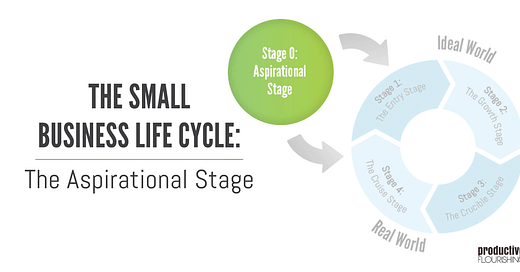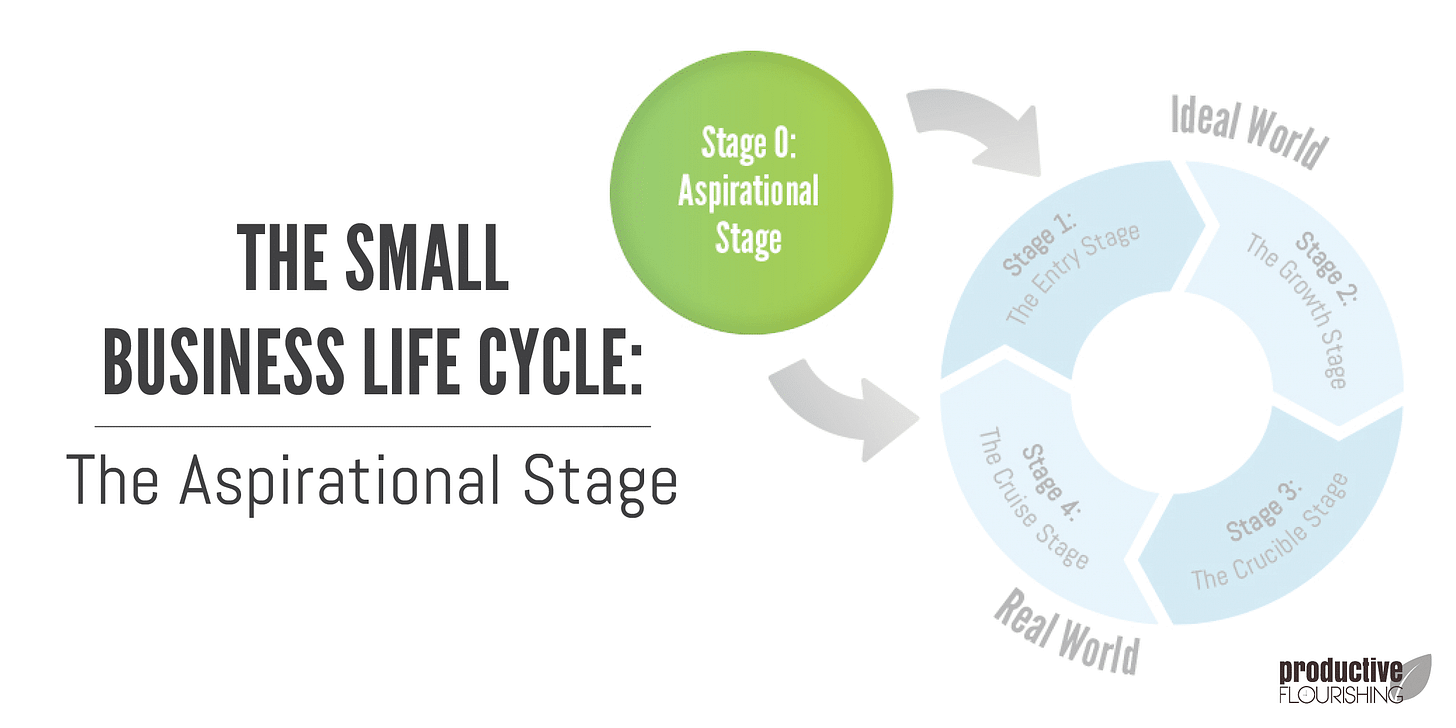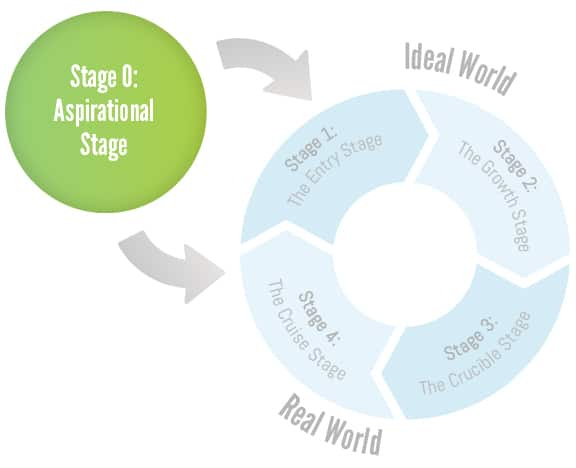In the world of small and microbusinesses, the rate of development and growth looks different than it does in traditional businesses or much bigger businesses. One size doesn't fit all when we look at particular growth patterns and how growth looks and feels within our businesses.
I've been developing and exploring this framework with clients and partners for a few years now and figured it was time to publicly write more about it, especially given how much of it informs the book I'm writing. In this series, we'll discuss the different steps and stages in the business life cycle for small businesses and microbusinesses and how to get through these cycles without the overwhelm and the feeling that "you just can't get it right."
If you take a look at business literature, what you'll notice is there's a pretty big gulch between when you want to start a business and when your business is already established and growing. There's this very crucial gap when you've already started, but you're not big and sustainable enough to use much of what's there. Businesses at this stage and scale are really hard to put your finger on what exactly they are, what the right size of it is — and frankly they're not big enough and making enough money for most consultants and the people who write about businesses to pay attention to. You're too small to matter.
Something is fundamentally wrong when 90% of our businesses are too small to matter and only 10% actually get the growing concern. Those businesses that are in that gap after they've started and before they've gotten big enough — to, say, more than 20 people — need the concern and counsel of the traditional business world.
Fundamentally, what we have to remember when we're getting business counsel is what we need to do really depends on where we are. (Click to tweet — thanks!) This discussion will give you the landscape of where you might be, so you know what you need to do to take steps going forward.
Every stage of business has its own challenges, strengths, inconvenient truths, ways forward, and catalytic moments. Remember: every stage of business has its own challenges and its advantages. There are no free lunches here, and no matter how cool it is to look from here at how much you want to be there — wherever "there" is — understand that once you get there, there will still be challenges.
So, a Quick Overview...
There are five stages of the small business life cycle. Stage 0 — the Aspirational stage — is a logical placeholder for all the people who want to start a business. They read books about business, or they sit in school dreaming about starting a business, but they haven't actually started one yet.
Stage 1 is the Entry stage. This is the stage of business in which they have already started the business. It's already getting a little bit of traction, but you really don't have a lot of customers and/or market share and/or demand for what you do.
Stage 2 is the Growth stage. The business is already going, you have customers and market demand, you've had a few things going on that give you a lot of excitement about what to do, and business is taking off. I like to refer to this stage as the riding the rocket stage.
Stage 3 is the Crucible stage. This is the stage of business that's awkward, it's challenging, and there's generally some type of catch-22 involved. If you had more business you could make more money, and if you had more money you could get more business. If you had a bigger team you could do more, and if you could do more you could get a bigger team. There's some type of constriction in the growth of the business that normally amounts to there not being enough business under the business.
Finally, Stage 4 is the Cruise stage. You've got your systems, people, processes, and positioning in place. You focus on the things you can do indefinitely that meet that sweet spot between market demand, your interest, and what you can do long term.
This is a life cycle because in the entrepreneurial world, we'll often do things that change our position and start the cycle anew. We might be in Stage 3 and have a lucky break and start a new offer or a new business visibility that gets us back in the growth stage, but we still haven't fundamentally fixed whatever had us stuck in Stage 3. We might be in Stage 4 and do something like write a book or be introduced to a new market or have some unforeseen or unexpected event happen that pushes us into a different stage of the lifecycle. Generally, it's harder to move up and stay up than it is to move back down the cycle and stay there.
Challenges of Stage 0
One of the main challenges is an extension of Barry Schwartz’s insight from his book, The Paradox of Choice, that shows that having more choices often leads to less choosing. Having so many possibilities around what business you could start can make it harder for you to choose which business to start.
The second challenge of the Aspirational stage is making the leap from the status quo. Making that leap is hard. People will tell you that it's better to keep your job. They don't understand what you're doing, and this is especially true if you already have a good job at a place like Google or another one of the whiz-bang companies that everyone wants to work for. Trying to buck the status quo is a huge challenge if you're still shaky and lacking the confidence for starting a business.
The third challenge of Stage 0 is the enormity of changing the world. Everything is so big. Not only are there so many different ways to start a business, but you're also thinking about the kind of mark you're trying to make in the universe. The enormity of changing the world can be so big that people decide they don't have it in them to do it, and so they don't.
Strengths of Stage 0
One of the strengths of Stage 0 is that you still have hope. You haven’t been burned, you haven’t had a slump month, season, or year, and you haven’t invested months and many thousands of dollars in something only to have it crash in a blaze of publicly humiliating glory. You still have pure, unadulterated hope - and hope is a powerful thing.
Because you haven't started, you have a lot of energy. You haven't walked the road of entrepreneurship and business building yet and thus aren't tired.
Another strength —and it's such a precious thing — is that anything counts as a win. Any advance you have in your business, any hint of interest, anything that gets you money or helps you see that your idea might work, counts as a win.
The Inconvenient Truth
There's an inconvenient truth at Stage 0, and this truth keeps people in Stage 0. That inconvenient truth is that your business might not work. Whatever the idea is, it might not be viable, there might not be a market for it, or you might not have the resources for it. This truth has existed for everyone who has ever started a business.
The Way Ahead
So, what is the way ahead when you're at Stage 0? It's one of those statements that's simple, but not easy, and here it is: Just start. Pick an idea you're really passionate about or that you believe you can help somebody with, and start. It won't be perfect, but it will never be perfect. It may be ungraceful, but that's kind of the point. The only way you can build the business you're thinking about is to start.
The Catalytic Moment
A catalytic moment happens here that moves you from Stage 0 to Stage 1. You see some frustration you can solve in the world, you try something, and it works - just a tiny bit. You can see through all the fear and the inconvenient truth, and you think, "Wait a second — there's a possibility here that I can do this." And you start that business.
Editor’s Note: This is the first in a 5-part series on The Small Business Life Cycle. Continue with the series by reading about the Entry stage.
This post was expanded upon in my best-selling book, The Small Business Life Cycle. In it, I discuss the steps that need to be taken at each stage. To learn more about how to transition and thrive in your small business or microbusiness, get your copy here.






